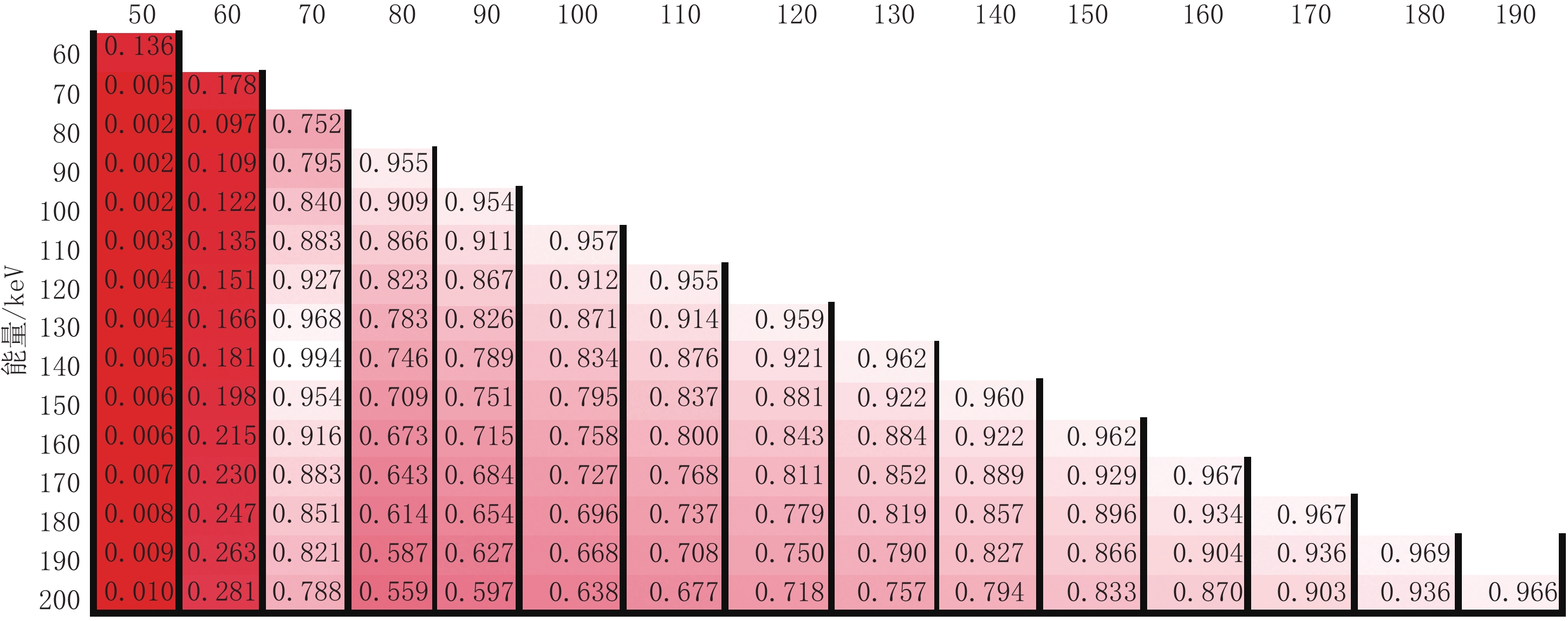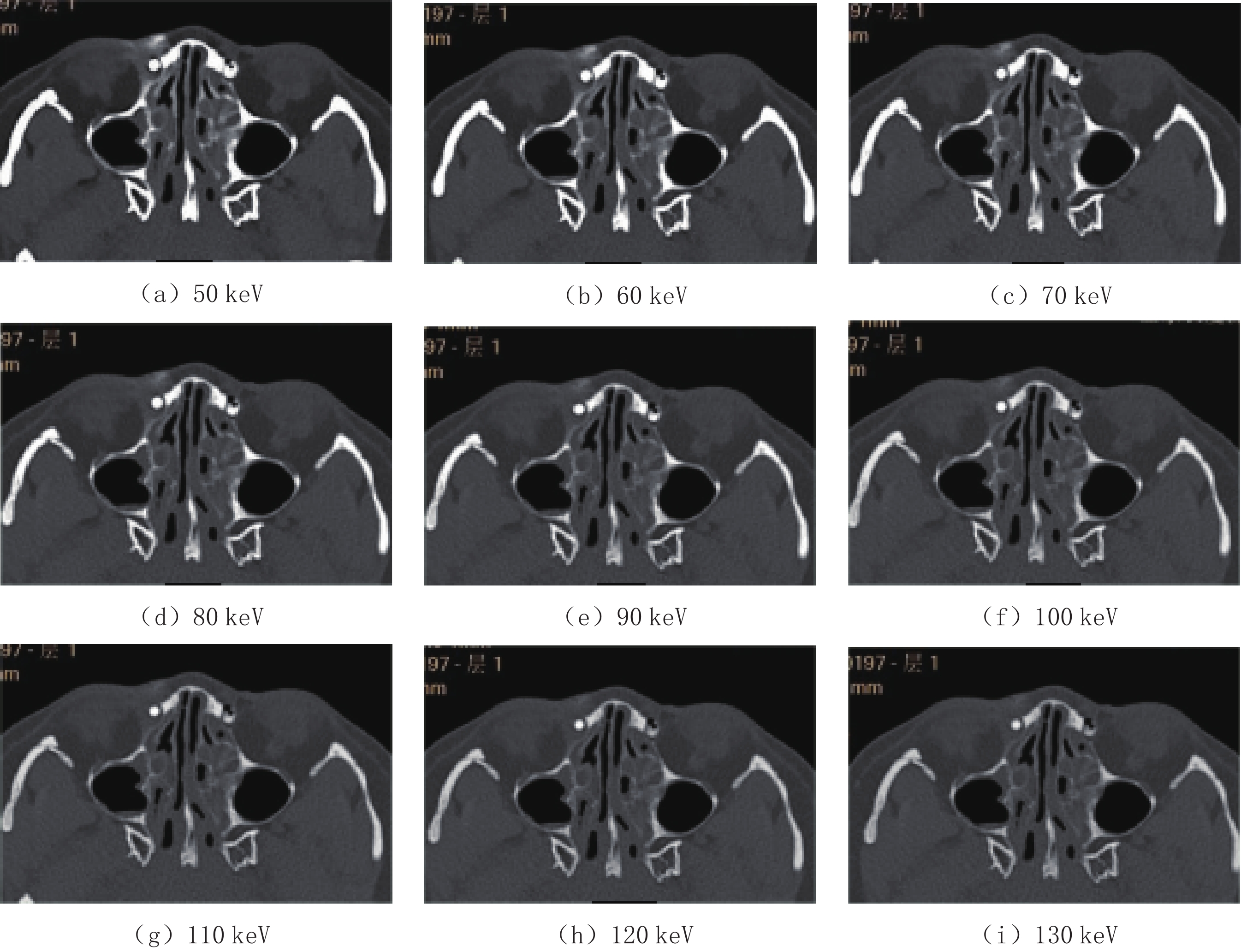The Application Value of Monoenergetic Imaging on Dual-layer Spectral Detector Computed Tomography in Dacryocystography
-
摘要:
目的:探讨双层探测器光谱CT单能量成像在泪道造影中的临床应用价值。方法:对临床怀疑泪道阻塞的患者行光谱CT泪道扫描,将光谱CT的各单能量keV图像的信号噪声比(SNR)和对比噪声比(CNR)做比较,对图像质量进行主观评分,并对患者泪道阻塞部位和狭窄程度与手术或内镜比对进行诊断符合率评估。结果:50 keV图像的SNR为9.76±13.44,比70~200 keV图像的SNR高,有统计学意义;50 keV图像的CNR为10.24±13.88,比70~200 keV图像的CNR高,有统计学意义。50 keV和常规图像质量主观评分分别为(5,5)和(4,5),医师间主观评分一致性良好。结论:50 keV单能量图像显著提高CT泪道造影的信噪比和对比噪声比且主观评分一致性良好。
Abstract:Objective: This study aimed to explore the value of monoenergetic imaging using dual-layer spectral detector computed tomography (CT) for dacryocystography. Methods: Dacryocystography was performed in patients with clinically suspected lacrimal duct obstruction using a Philips IQon dual-layer spectral detector CT. The objective evaluation included the signal-to-noise ratio (SNR) and contrast-to-noise ratio (CNR) of each monoenergetic image, subjective rating of image quality, and the site and degree of lacrimal duct obstruction. Results: The SNR and CNR of 50 keV images was 9.76±13.44 and 10.24±13.88, respectively, which were significantly lower than that of 70~200 keV images. The subjective scores for 50 keV and conventional image quality were (5, 5) and (4, 5), respectively, indicating good consistency in subjective scores among radiologists. Conclusion: The SNR and CNR of CT dacryocystography increased significantly at 50 keV.
-
Keywords:
- spectral CT /
- mono energetic imaging /
- dacryocystography
-
泪道阻塞是眼科常见的疾病,临床以中老年患者较为常见,其中女性多于男性[1]。泪道阻塞的影像学检查方法主要有CT泪道造影、泪道超声检查、MR泪道钆造影及MR泪道水成像等[2]。CT泪道造影相对于其他影像学检查有更高的密度分辨率及较小的周围骨性结构的影响干扰[3],光谱CT可对原始数据进行重建得到不同能量的单能量图像。
本研究旨在探究双层探测器光谱CT单能量成像在泪道造影中的临床应用价值。
1. 资料和方法
1.1 一般资料
选取2020年9月至2022年11月因溢泪临床初步诊断泪道阻塞行CT泪道扫描的病例44例,其中CT泪道造影的46眼;男性9例,女性35例,年龄21.35~74.37岁,平均年龄49.14岁。
纳入标准:所有患者均因溢泪就诊并在行CT泪道造影前进行泪道冲洗,初步诊断为泪道阻塞;所有患者均无碘对比剂过敏史。
排除标准:有明显运动伪影不能评估的。
1.2 仪器设备与药品
采用Philips Healthcare Iqon spectral CT进行SBI模式扫描。对比剂采用非离子型碘对比剂碘佛醇(规格100 mL∶35 g(I))。
1.3 采集方法与扫描参数
临床医生对初步诊断泪道阻塞患者进行泪道冲洗后,在双眼下泪小点处注射对比剂碘佛醇,每侧对比剂总量1~5 mL,对比剂从上泪小点返流即停止注射,依据患者泪道狭窄或阻塞的程度相应变化。患者再至CT室行CT泪道扫描。自注射对比剂开始计时,CT泪道扫描距注射对比剂时间不超过40 min。扫描前嘱患者在检查期间静止不动,双眼自然闭合,眼球不要转动。
扫描体位:患者仰卧于扫描床上,听眦线垂直于床面。扫描范围自眶上缘到硬腭上缘。扫描参数:管电压120 kVp,管电流采用自动调制技术,X线管转速0.75 s/r,螺距0.390,层厚1 mm,层间距1 mm,重建矩阵为512×512。
1.4 后处理方案及数据处理
所有病例均在Philips Portal后处理工作站上进行MonoE 40~200 keV及拟常规kV(conventional)图像重建(70 keV单能量图像),图像骨窗算法为YB算法,窗宽
1500 、窗位500。以对比剂聚集区域为中心,对骨性泪道进行轴位、冠状位、斜矢状位进行多平面重建。50~200 keV测定泪道内CT值、同层同侧面部脂肪CT值、泪道内SD值,对各单能量图像的信号噪声比(signal-to-noise ratio,SNR)及对比噪声比(contrast-to-noise ratio,CNR)进行比较。
1.5 图像评价方法
1.5.1 客观评价
测定患者图像信号噪声比SNR、对比噪声比CNR。图像噪声:泪道内CT值的标准差(SD)。SNR=泪道内的CT值/SD,CNR=(泪道内CT值 - 脂肪CT值)/SD。
选取感兴趣区ROI,泪道内ROI选取在对比剂充盈的区域、避开骨质及空气,脂肪ROI选取同层同侧面部脂肪。同一病例泪道、脂肪组织的ROI的形状大小均一致,大小约为3~5 mm2。每个病例的数据均测量3个,取平均值。
1.5.2 主观评价
图像均由一名中年资影像诊断医生及一名高年资影像诊断医生进行双盲法评价图像质量,对泪小管、泪囊、鼻泪管等的解剖结构及阻塞部位、程度显示进行评价。
评分标准[4]:5分,解剖结构及细节显示清楚,阻塞部位及程度显示佳;4分,解剖结构显示较清楚,阻塞部位及程度显示较好;3分,解剖结构及阻塞部位、程度显示基本满足诊断要求;2分,解剖结构及阻塞部位、程度显示不清楚,细节不足以满足诊断;1分,解剖结构及阻塞部位、程度显示模糊,不能诊断。两名医师主观评分的平均值用于组间分析。
术前冲洗、内窥镜及术中探通标准[5]为:①泪小点阻塞:裂隙灯下见泪小点阻塞;②泪小管阻塞:冲洗针从泪点进入泪道,前进时不能触及骨壁且冲洗液返回;③泪总管阻塞:冲洗探针不可触及骨壁,冲洗液从上泪小点进入、下泪小点反流,冲洗液从下泪小点进入、上泪小点反流;④泪囊、鼻泪管阻塞:冲洗探针可触及骨壁,冲洗液从上泪小点进入、下泪小点反流,冲洗液从下泪小点进入、上泪小点反流。内窥镜及手术与CT检查间隔24 h以上。
1.6 统计学方法
采用SPSS 20.0软件,正态分布计量资料采用
$ (\bar{x}\pm s) $ ,组间计量资料比较采用方差分析,组间两两比较采用LSD检验。P<0.05为差异有统计学意义。2. 结果
2.1 客观评价结果
SNR与CNR数值符合正态分布。50 keV图像的SNR为9.76±13.44,比70~200 keV图像的SNR高,有统计学意义;50 keV图像的CNR为10.24±13.88,比70~200 keV图像的CNR高,有统计学意义(表1、图1和图2)。
表 1 50~200 keV单能量图像信噪比和对比噪声比的比较$ (\bar{x}\pm s) $ Table 1. SNR and CNR comparison of 50~200 keV monoenergetic images项目 能量/ keV 50 60 70 80 90 100 110 120 SNR 9.76±13.44 7.29±9.23 5.01±4.55 4.43±3.38 4.46±3.32 4.50±3.26 4.53±3.17 4.56±3.09 CNR 10.24±13.88 7.68±9.43 5.37±4.75 4.83±3.63 4.92±3.60 5.02±3.56 5.11±5.11 5.21±3.42 130 140 150 160 170 180 190 200 SNR 4.59±3.00 4.61±2.90 4.64±2.82 4.67±2.76 4.69±2.70 4.72±2.66 4.74±2.63 4.77±2.64 CNR 5.30±3.33 5.38±3.23 5.47±3.16 5.55±3.10 5.62±3.02 5.69±2.97 5.76±2.94 5.83±2.94 2.2 主观评价结果
根据客观评价的结果,50 keV组图像较其他组图像信噪比及对比噪声比的比较有统计学差异,故两名医师对50 keV组图像和常规图像(即混合能量图像)进行主观评分,结果:50 keV组评分均为(5,5),常规组评分均为(4,5)。两名医师的主观评分具有良好的一致性,50 keV组的主观评分完全一致,常规组两名医师主观评分Kappa值为0.615。
50 keV组及常规混合能量组的诊断泪小管阻塞均为9眼,诊断为泪总管阻塞均为22眼,诊断为泪囊、鼻泪管阻塞均为15眼,与内镜或手术相比较完全一致。
3. 讨论
泪道阻塞性疾病主要临床表现为溢泪[6],长期泪道阻塞严重影响到患者的生活质量[7]。根据阻塞的部位可分为上泪道阻塞、下泪道阻塞、全泪道阻塞,不同部位的阻塞及阻塞程度有相应最优的手术方案,因此术前明确阻塞部位及阻塞程度有重要意义[8-9]。有研究显示CT泪道造影可直观显示泪道有无阻塞及阻塞部位[10],对泪囊大小及与周围组织的关系提供影像依据[11],MPR技术对显示泪道梗阻部位有一定意义[12],本研究旨在探索双层探测器光谱CT在CT泪道扫描中的临床应用价值。
常规CT成像是基于物质衰减来得到密度差异,双层探测器光谱CT能在物质衰减的基础上基于原始数据的能量解析[13],光谱CT的双层探测器的上层,采用的稀有金属钇(Yttrium)为基质的闪烁晶体,高能光子穿过,仅吸收低能光子,低能光子从侧置通道传出;光谱CT的双层探测器下层则吸收高能光子。不同能量下物质衰减不一样,因此不同单能量下的信息不一样[14],而高、低能的数据经过能量解析后,以SBI数据储存[15],可进行40~200 keV之间任意能量进行重建。
泪道从上、下泪小点向内移行为上、下泪小管,汇成泪总管、泪囊,再移行为被骨质包围的鼻泪管,整个泪道的周围组织结构从暴露于体外到周围有软组织,再到被骨质包围,常规混合能量的CT图像与不同能量的单能量图像对泪道的评价以及泪道阻塞部位和狭窄程度的评估显得尤为重要。本研究结果显示各单能量图像的泪道阻塞部位诊断与内镜或手术的符合率完全一致,骨窗下评价CT泪道造影传统CT混合能量成像已具较高的诊断符合率。
双层探测器光谱CT利用高、低双能数据模拟计算出单一能量40~200 keV下的单能量图像,低能量单能量图像(小于70 keV)因为更靠近碘K缘(33 keV)而能明显提高碘的CT值,本研究结果显示单能量50 keV较70~200 keV单能量图像的SNR及CNR与其他单能量图像有统计学差异,于泪道的显示更明显,与周围组织的差异更明显(图3)。
既往研究显示低能量图像对比较好[16-17],与本研究结果接近。而高能量单能量图像(大于90 keV)能明显降低射线硬化伪影[18],本研究在测量评价时,未发现明显射线硬化伪影,原因可能是在经泪小点注射对比剂前对泪道进行生理盐水的冲洗,对比剂进入泪道时有一定的稀释作用。但本研究在测ROI的CT值及SD值时,发现40 keV单能量图像中CT值
3071 HU,SD值0的情况,说明MonoE太低,CT值超出可以测出的最大范围,无法比较图像的SNR及CNR,也鉴于此原因而未将40 keV单能量图像纳入研究。而相关的文献中较少出现类似情况,可能原因是其他部位的CT增强或CT血管成像注射对比剂入血,在体内有稀释,同时生理盐水的后续团注也会增大稀释;而泪道CT造影此检查中,对于泪道通畅的病例,并没有注射对比剂后生理盐水的稀释作用,所测ROI的CT值相当于直接测量对比剂的CT值,因而出现低单能量下超出CT值测量范围。本研究的局限性。本研究的患者在眼科注射完毕对比剂后至CT扫描的时间不一,约10~40 min不等;部分患者泪道局限性狭窄可能因为注射对比剂后到CT扫描时间过长而导致对比剂流走或吸收而无法确切显示狭窄部位。后续研究也将考虑包括对比剂稀释、泪道通畅程度造成对比剂是否稀释及稀释程度、对比剂注射时间等以上因素进一步研究。
综上所述,50 keV单能量图像显著提高了CT泪道造影的信噪比(SNR)和对比噪声比(CNR),主观评分一致性良好。
-
表 1 50~200 keV单能量图像信噪比和对比噪声比的比较
$ (\bar{x}\pm s) $ Table 1 SNR and CNR comparison of 50~200 keV monoenergetic images
项目 能量/ keV 50 60 70 80 90 100 110 120 SNR 9.76±13.44 7.29±9.23 5.01±4.55 4.43±3.38 4.46±3.32 4.50±3.26 4.53±3.17 4.56±3.09 CNR 10.24±13.88 7.68±9.43 5.37±4.75 4.83±3.63 4.92±3.60 5.02±3.56 5.11±5.11 5.21±3.42 130 140 150 160 170 180 190 200 SNR 4.59±3.00 4.61±2.90 4.64±2.82 4.67±2.76 4.69±2.70 4.72±2.66 4.74±2.63 4.77±2.64 CNR 5.30±3.33 5.38±3.23 5.47±3.16 5.55±3.10 5.62±3.02 5.69±2.97 5.76±2.94 5.83±2.94 -
[1] 刘爽, 陶海, 王伟. 泪道阻塞性疾病的流行病学研究进展[J]. 国际眼科杂志, 2008, (1): 140−143. LIU S, TAO H, WANG W, et al. Research progress in epidemiology of lacrimal duct obstruction diseases[J]. International Journal of Ophthalmology, 2008, (1): 140−143. (in Chinese).
[2] 陶海, 马志中, 侯世科, 等. 泪道阻塞性疾病的诊断研究进展[J]. 国际眼科杂志, 2009, 9(2): 342−346. TAO H, MA Z Z, HOU S K, et al. Current advance on diagnosis of lacrimal duct obstruction diseases[J]. International Journal of Ophthalmology, 2009, 9(2): 342−346. (in Chinese).
[3] 刘晓航, 陶海. 泪道超声检查研究进展[J]. 眼科新进展, 2012, 32(7): 697−700. LIU X H, TAO H. Research advances in ultrasonography of lacrimal passage[J]. Recent Advances in Ophthalmology, 2012, 32(7): 697−700. (in Chinese).
[4] 曾宪春, 张俊, 韩丹, 等. 多层螺旋CT眼眶扫描参数优化的离体标本实验研究[J]. 中国医学影像学杂志, 2013, 21(7): 497−500. ZENG X C, ZHANG J, HAN D, et al. In vitro specimen study for parameter optimization of multislice spiral CT orbital scanning[J]. Chinese Journal of Medical Imaging, 2013, 21(7): 497−500. (in Chinese).
[5] 张文博. 不同类型置管方式在泪道阻塞疾病中的疗效比较及影响因素分析[D]. 武汉: 华中科技大学, 2020. ZHANG W B. The efficacy of different types of silicone intubation in the treatment of lacrimal duct obstruction and analysis of influential factors to the prognosis[D]. Wuhan: Huazhong University of Science and Technology, 2020. (in Chinese).
[6] JANSSEN A G, MANSOUR K, BOS J J, et al. Diameter of the bony lacrimal canal: Normal values and values related to nasolacrimal duct obstruction: Assessment with CT[J]. American Journal of Neuroradiology, 2001, 22(5): 845−850.
[7] GUPTA N, CHAWLA N, GANESH S, et al. Prevalence of buried probe in complex congenital nasolacrimal duct obstruction and evaluation of its success rate post “probing and irrigation”: A retrospective study[J]. Orbit, 2018, 37(6): 397−400. DOI: 10.1080/01676830.2018.1435695.
[8] 于泓, 韩冬梅, 杨瑞民, 等. 泪道激光联合引流管置入治疗泪道阻塞的疗效及其影响因素[J]. 眼科, 2017, 26(6): 383−385. [9] 谭思敏, 梁德茂. Nd: YAG激光泪道成形术联合泪道支架置入治疗泪道阻塞的疗效及影响因素[J]. 国际眼科杂志, 2020, 20(11): 1979-1982. TAN S M, LIANG D M. Effect and influencing factors of Nd: YAG laser dacryocystoplasty combined with lacrimal stent implantation in the treatment of lacrimal duct obstruction[J]. International Eye Science, 2020, 20(11): 1979-1982. (in Chinese).
[10] 殷亮, 李三立, 谭世奇, 等. 64层螺旋CT泪囊造影在评价泪系病变中的临床应用[J]. 实用医学影像杂志, 2012, 13(1): 12−13. YIN L, LI S L, TAN S Q, et al. Clinical application of 64-slice spiral CT dacryocystography in evaluating lacrimal system lesions[J]. Journal of Practical Medical Imaging, 2012, 13(1): 12−13. (in Chinese).
[11] 甘莆英, 刘琪, 王耀华, 等. CT-泪道造影术(CT-DCG)在泪道阻塞性疾病中的临床应用[J]. 眼科新进展, 2019, 39(3): 264−266. GAN P Y, LIU Q, WANG Y H, et al. Clinical application of computed tomography-dacryocystography (CT-DCG) in lacrimal duct obstructive diseases[J]. Recent Advances in Ophthalmology, 2019, 39(3): 264−266. (in Chinese).
[12] 关长旭. 泪道造影CT结合MPR在泪道炎性狭窄中的初步研究[J]. 内蒙古医科大学学报, 2022, 44(1): 47−49. [13] WASHIO H, OHIRA S, KARINO T, et al. Accuracy of quantification of iodine and hounsfield unit values on virtual monochromatic imaging using dual-energy computed tomography: Comparison of dual-layer computed tomography with fast kilovolt-switching computed tomography[J]. Journal of Computer Assisted Tomography, 2018, 42(6): 965−971. DOI: 10.1097/RCT.0000000000000798. (in Chinese).
[14] ALBRECHT M H, VOGL T J, MARTIN S S, et al. Review of clinical applications for virtual monoenergetic dual-energy CT[J]. Radiology, 2019, 293(2): 260−271. DOI: 10.1148/radiol.2019182297.
[15] MEGIBOW A J, KAMBADAKONE A, ANANTHAKRISHNAN L. Dual-energy computed tomography: Image acquisition, processing, and workflow[J]. Radiologic Clinics of North America, 2018, 56(4): 507−520. DOI: 10.1016/j.rcl.2018.03.001.
[16] 刘秀丽, 张戟风, 刘景旺, 等. 能谱CT在中央型肺癌伴阻塞性肺不张诊断及放疗定位中应用价值[J]. CT理论与应用研究, 2023, 32(4): 509−514. DOI: 10.15953/j.ctta.2022.164. LIU X L, ZHANG J F, LIU J W, et al. The value of spectral CT in differential diagnosis and radiotherapy localiation of central lung cancer with obstructive atelectasis[J]. CT Theory and Applications, 2023, 32(4): 509−514. DOI: 10.15953/j.ctta.2022.164. (in Chinese).
[17] 杨创勃, 于楠, 马光明, 等. 能谱CT最佳单能量图像联合MPR在腰骶部周围神经检查中的应用[J]. 影像诊断与介入放射学, 2020, 29(5): 356−360. YANG C B, YU N, MA G M, et al. Value of dual-energy spectral CT at optimal energy level with multiplanar reformation for diagnosing lumbosacral peripheral neuropathy[J]. Diagnostic Imaging & Interventional Radiology, 2020, 29(5): 356−360. (in Chinese).
[18] NAGAYAMA Y, NAKAURA T, ODA S, et al. Dual-layer DECT for multiphasic hepatic CT with 50 percent iodine load: A matched-pair comparison with a 120 kVp protocol[J]. European Radiology, 2018, 28(4): 1719−1730. DOI: 10.1007/s00330-017-5114-3.





 下载:
下载:





